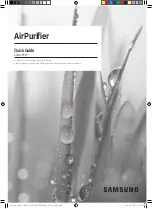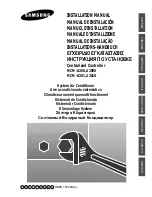
25
REFRIGERANT PIPING cont.
(ASHRAE Handbook 2006 - Refrigeration p.
2.19). Hot gas bypass pipe diameters are
selected to maintain velocity below a maximum
4000 fpm, while a minimum criteria guarantees
oil return up vertical rise sections, as with the
suction line (ASHRAE Handbook 2006 –
Refrigeration p. 2.20).
• Acceptable pressure loss criteria are applied to
each of the lines: The total equivalent length of
the liquid line available is determined such that
3°F of liquid sub-cooling remain at the TXV.
This includes the pressure losses in horizontal
and vertical sections, accessories, elbows, etc.
Recall that the available sub-cooling for the cycle
is assumed as 10°F. To maintain at least 3°F sub-
cooling as a factor of safety to avoid flashing at
the TXV, we consider a maximum pressure loss
equivalent to a 7°F change in saturation
temperature. Pressure losses in the suction line
are not to exceed 2°F. When sizing the hot gas
bypass line we consider a maximum acceptable
pressure loss in the hot gas bypass line with R-22
to be 20 psi, 30 psi with R-410A refrigerant.
When to use predetermined line sizing:
The line sizes presented are not the only
acceptable pipe diameters, they are however
appropriate for general comfort cooling
applications, and satisfy common job
requirements. Examine the conditions,
assumptions, and constraints used in the
generation of the predetermined pipe diameters
to ensure that this method is applicable to a
particular case. Do not assume that these line
sizes are appropriate for every case. Consult
ASHRAE Handbook – Refrigeration 2006 for
generally accepted system practices.
How to use predetermined line sizing:
First, read the previous section entitled
(When to
use predetermined line sizing)
to decide if this
method is applicable.
Second, determine the refrigerant being used,
AAON offers CL products with R-410A and R-
22 refrigerants, and the line sizes are not
identical for both.
Next, determine whether the product is operating
with single, or dual circuited compressors.
Locate the appropriate table of line sizes:
TABLE RP-1: Dual Circuited R-410A
condensers
TABLE RP-2: Dual Circuited R-22 condensers
TABLE RP-3: Single Circuited R-410A
condensers
TABLE RP-4: Single Circuited R-22 condensers
Locate the Model number in the table. For each
model, the circuits are listed, along with the pipe
diameters of the connection sizes, and the
diameters of the predetermined line size.
A figure accompanies each table.
FIGURE RP-1: Dual circuited R-410A
condensers
FIGURE RP-2: Dual circuited R-22 condensers
FIGURE RP-3: Single circuited R-410A
condensers
FIGURE RP-4 Single circuited R-22 condensers
Examine the appropriate figure to determine the
acceptable line dimensions. The figure is shown
as total available riser height versus total
equivalent line length for the liquid line. This
curve identifies a region of acceptable piping
configuration when the predetermined line sizes
are selected for any model in the table. A piping
configuration above the curve falls outside the
assumptions used to determine the line size and
will result in a loss of sub-cooling, and additional
pressure losses in the suction and hot gas bypass
lines. The total equivalent line length definition
includes the height of vertical rise, pressure drop
through elbows and accessories, and horizontal
line length, so elbows, accessories and vertical
rise must be considered when determining
horizontal length available from the total
equivalent line length.
This figure is presented in terms of the liquid
line, but it assumes that the line lengths for the
suction and hot gas bypass are similar, as these
lines will commonly be routed together to
minimize the space and cost required for split
system installation.
















































